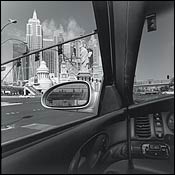
For The American Monument, a book of about 200 pictures published in 1976, Lee Friedlander traveled across the country photographing monuments wherever he found them—town squares, cemeteries, parks, roadsides, and so on. The project sounds like coffee-table civics, but in fact The American Monument is a soulful American masterpiece. The Puritans, generals, priests, muses, and ordinary Joes become, as the viewer turns the pages, poignant characters in a flux-filled dream, their eternal stares and platonic aspirations constantly bedeviled by the rude, vital, and unreliable present. Friedlander doesn’t just knock statues off pedestals. That’d be too easy: He can also admire what he upends. He would rather capture the tension between past and present, real and ideal, than pick sides. “Do I contradict myself?” Whitman asked, in those famous lines that also describe America so well. “Very well then I contradict myself, / (I am large—I contain multitudes.)”
In the “Friedlander” retrospective now at the Museum of Modern Art, Peter Galassi is exhibiting about 500 photographs, a truly monumental number—perhaps a record for a photography exhibit—that would ordinarily deserve a Bronx cheer. How can a viewer possibly take in so many images? And yet, there’s a rightness to the scale. Friedlander has a prolific, endlessly expansive sensibility. And the effect of his work, as Galassi suggests, depends upon more than the sensation created by the individual photograph viewed in isolation. Friedlander creates complex medleys of meaning among various photographs, instinctively working in books and series. (The images in this show are clustered around 60 themes.) He’s not a “decisive moment” man, to use Henri Cartier-Bresson’s famous phrase. He shows us “the decisive moment … and then.” He’s a verb, not a noun, a rhythm instead of a melody. In short, he’s well suited to portray this country. Not surprisingly, Friedlander was deeply influenced as a young man by that most American of art forms, jazz.
Now 70 years old, Friedlander began working during the golden age of magazine photography in the fifties and sixties. That period was also a time of grandiloquent visual platitudes about “mankind” and “America.” Together with a number of other photographers—among them Robert Frank, Gary Winogrand, and Diane Arbus—Friedlander dropped the piety and began telling the truth as he really saw it. He would go out into the world the way a magazine photographer on assignment would, but returned with spreads too fresh for most magazines to publish. Early in the sixties, he became a master of the throbbing American street, with its cacophony of signs, strangely syncopated spaces, and helter-skelter juxtapositions. He has continued to find inspiration there. In a 2002 photograph of Las Vegas, for example, he kaleidoscoped many kinds of space—the up close and far away, the interior of a car, the reflection in a mirror, the view out the windshield, the view out the side window. Within this visual swirl, the Statue of Liberty at the New York–New York hotel emerges like a greeter before the Vegas high-rises. America never needed Surrealism: America is surreal.
Even when his subject is not the street per se, Friedlander celebrates what amounts to street truths. If his subject is a friend, he doesn’t compose a picture that looks like a profound portrait, but, instead, makes what could almost be a great family snap. If his subject is a nude, he makes sure she is also naked. The distant view does not take priority over the immediately at hand: Foreground usually matters just as much as background. In recent years, Friedlander has begun making landscapes, often of the American West, which is yet another monumental subject. He’s not averse to purple mountains’ majesty, but also relishes the unweeded West and insists upon nature’s crazy tangles. A wit called these landscapes “Ansel Adams on crack,” but they’re not as deranged as that sounds. There’s something judicious about them: The overlooked gets its due. Despite his love of flux—he’s what De Kooning called a “slipping glimpser”—the images Friedlander creates invariably appear visually stable and strongly built. He has a carpenter’s eye. An eccentric carpenter, to be sure.
Despite his great ambition, Friedlander is unusually modest—especially when compared with other artists today. He hasn’t set out to create an instantly recognizable brand-name style that announces “Friedlander.” He doesn’t appear haunted or driven by anger. He isn’t narcissistic, morbidly introspective, and all about moi. Rather than impose himself upon the world, he seems to take what’s given, trusting that there’s always more where that came from and that he’ll find himself in whatever he photographs. For such a prolific artist, he’s made remarkably few formal self-portraits. Instead, he sometimes lets his own shadow fall into the frame, becoming part of the scenery.
Friedlander
Museum of Modern Art.
Through August 29.